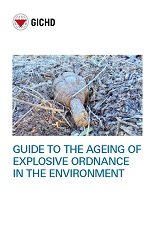The GICHD Guide to Ageing of Explosive Ordnance in the Environment seeks to provide a summary of what is known to date on this subject. Building on research conducted by partners in the sector over recent decades, this guide is extensively illustrated with photographs of examples from the field. The guide will be of use not only to explosive ordnance disposal operators and deminers in the field, but may also assist those planning for the ongoing challenge of residual contamination.
Ageing of explosive ordnance affects the risk an item presents, which changes as it weathers in the environment. An item’s appearance, which is so important for identification, can also change. As metallic components degrade, the challenge of detecting items using electro magnetic induction technology also becomes more difficult.
The guide covers a range of explosive ordnance that has aged in the environment, including explosive remnants of war (ERW), anti-personnel (AP) and anti-vehicle (AV) mines, and improvised mines/improvised explosive devices. It attempts to identify which factors are involved in ageing and how these impact explosive ordnance. Case studies are presented and may be added to and updated in future, with more examples from the field.
Categories: Detection and clearance, Environment, Explosive Ordnance Risk Education (EORE), Residual contamination, Land release

